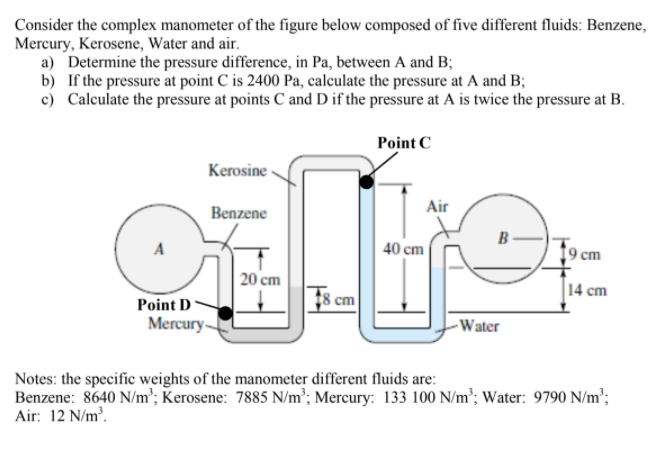Consider the complex manometer of the figure below composed of five different fluids: Benzene, Mercury, Kerosene, Water and air. a) Determine the pressure difference, in Pa, between A and B; b) If the pressure at point C is 2400 Pa, calculate the pressure at A and B; c) Calculate the pressure at points C and D if the pressure at A is twice the pressure at B. Point C Kerosine - Benzene Air B - 40 cm 9 cm | 20 cm 14 cm 8 cm Point D Mercury -Water Notes: the specific weights of the manometer different fluids are: Benzene: 8640 N/m'; Kerosene: 7885 N/m²; Mercury: 133 100 N/m²; Water: 9790 N/m²; Air: 12 N/m'.
Consider the complex manometer of the figure below composed of five different fluids: Benzene, Mercury, Kerosene, Water and air. a) Determine the pressure difference, in Pa, between A and B; b) If the pressure at point C is 2400 Pa, calculate the pressure at A and B; c) Calculate the pressure at points C and D if the pressure at A is twice the pressure at B. Point C Kerosine - Benzene Air B - 40 cm 9 cm | 20 cm 14 cm 8 cm Point D Mercury -Water Notes: the specific weights of the manometer different fluids are: Benzene: 8640 N/m'; Kerosene: 7885 N/m²; Mercury: 133 100 N/m²; Water: 9790 N/m²; Air: 12 N/m'.
Elements Of Electromagnetics
7th Edition
ISBN:9780190698614
Author:Sadiku, Matthew N. O.
Publisher:Sadiku, Matthew N. O.
ChapterMA: Math Assessment
Section: Chapter Questions
Problem 1.1MA
Related questions
Question
Fluid

Transcribed Image Text:Consider the complex manometer of the figure below composed of five different fluids: Benzene,
Mercury, Kerosene, Water and air.
a) Determine the pressure difference, in Pa, between A and B;
b) If the pressure at point C is 2400 Pa, calculate the pressure at A and B;
c) Calculate the pressure at points C and D if the pressure at A is twice the pressure at B.
Point C
Kerosine -
Air
Benzene
40 cm
19 cm
|20 cm
14 cm
Point D
3 cm
Mercury-
-Water
Notes: the specific weights of the manometer different fluids are:
Benzene: 8640 N/m'; Kerosene: 7885 N/m²; Mercury: 133 100 N/m²; Water: 9790 N/m²;
Air: 12 N/m.
Expert Solution
This question has been solved!
Explore an expertly crafted, step-by-step solution for a thorough understanding of key concepts.
This is a popular solution!
Trending now
This is a popular solution!
Step by step
Solved in 4 steps with 1 images

Knowledge Booster
Learn more about
Need a deep-dive on the concept behind this application? Look no further. Learn more about this topic, mechanical-engineering and related others by exploring similar questions and additional content below.Recommended textbooks for you

Elements Of Electromagnetics
Mechanical Engineering
ISBN:
9780190698614
Author:
Sadiku, Matthew N. O.
Publisher:
Oxford University Press

Mechanics of Materials (10th Edition)
Mechanical Engineering
ISBN:
9780134319650
Author:
Russell C. Hibbeler
Publisher:
PEARSON

Thermodynamics: An Engineering Approach
Mechanical Engineering
ISBN:
9781259822674
Author:
Yunus A. Cengel Dr., Michael A. Boles
Publisher:
McGraw-Hill Education

Elements Of Electromagnetics
Mechanical Engineering
ISBN:
9780190698614
Author:
Sadiku, Matthew N. O.
Publisher:
Oxford University Press

Mechanics of Materials (10th Edition)
Mechanical Engineering
ISBN:
9780134319650
Author:
Russell C. Hibbeler
Publisher:
PEARSON

Thermodynamics: An Engineering Approach
Mechanical Engineering
ISBN:
9781259822674
Author:
Yunus A. Cengel Dr., Michael A. Boles
Publisher:
McGraw-Hill Education

Control Systems Engineering
Mechanical Engineering
ISBN:
9781118170519
Author:
Norman S. Nise
Publisher:
WILEY

Mechanics of Materials (MindTap Course List)
Mechanical Engineering
ISBN:
9781337093347
Author:
Barry J. Goodno, James M. Gere
Publisher:
Cengage Learning

Engineering Mechanics: Statics
Mechanical Engineering
ISBN:
9781118807330
Author:
James L. Meriam, L. G. Kraige, J. N. Bolton
Publisher:
WILEY